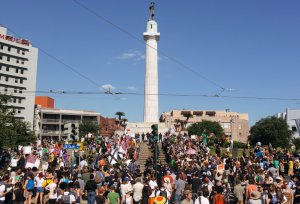What the Soviet bloc and the American South have in common
Source: The Washington Post / www.washingtonpost.com / By Charles Lane /
While he was still a dissident playwright living under a Communist system, Vaclav Havel produced possibly the most brilliant essay ever written on political oppression in Eastern Europe: “The Power of the Powerless.” This year marks the 40th anniversary of its appearance in opposition circles in 1978, which was followed swiftly by Havel’s arrest and imprisonment.

Communist rule is long gone in Europe. Yet anyone who doubts the relevance of Havel’s ideas should read another thought-provoking piece of political writing, “In the Shadow of Statues,” the newly published book by Mayor Mitch Landrieu of New Orleans.
What could Havel’s long-ago dissection of Soviet-bloc politics have in common with a U.S. politician’s memoir about carrying out a decision to dismantle his city’s monuments to Robert E. Lee and other Confederate heroes?
Both explain the power of truth.
Havel memorably asked his readers to imagine a greengrocer who obediently posts a hackneyed slogan — “workers of the world, unite!” — in the window of his shop. He asks us to imagine as well all the people who unthinkingly pass by each day. Everyone takes the slogan for granted; it’s part of the “panorama.” Havel defined the panorama as an ideologically manipulated urban landscape that communicates to people “where they are living and what is expected of them,” and what they must do, lest they lose “their peace and tranquility and security.” The panorama included not only shop-window slogans but also statues of Joseph Stalin, Vladimir Lenin and other Soviet heroes.
What would happen, Havel asked, if one fine day that greengrocer stopped going along to get along? If he started thinking about the panorama, instead of accepting it? Suppose he takes down the sign and begins “to say what he really thinks at political meetings,” or “even finds the strength in himself to express solidarity with those whom his conscience commands him to support.”
This “attempt to live within the truth,” as Havel put it, might imperil the individual who makes it, but it would simultaneously, through the power of example, lay a basis for wider change.
For Landrieu and other white New Orleanians, the Confederate statues that stood for decades in New Orleans were like the placard in Havel’s greengrocer’s window: part of the unquestioned “panorama” in his hometown. “Jefferson Davis was there-but-not-there as we drove by,” he recalls.
He took them for granted — until he didn’t. Prompted by his conversations with African American jazz legend Wynton Marsalis, and reacting to the 2015 massacre of black churchgoers by a white supremacist in Charleston, S.C., Landrieu started to see the statuary in a different light.
He learned the history behind them. They had been erected in the post-Civil War era by local authorities for propaganda purposes: to honor the “Lost Cause” of the Confederacy, yes, but also to show African Americans that white supremacy was still very much alive, and that resistance to it would not be tolerated.
And as Landrieu explored these truths, he began to find it possible to express solidarity with the city’s black residents on the issue; he saw the Lee statue through the eyes of African American children, who might wonder why a war-maker on behalf of slavery should enjoy an honored place in public space. That “pretty much did it for me,” he writes.
One does not want to overstate the similarities between Havel’s predicament and that of Landrieu, who, after all, was not a powerless denizen of a dictatorial state but an elected official in a democracy.
Yet one should not understate the parallel, either: Landrieu’s insistence on carrying out a city council ordinance to dismantle the monuments, after courts upheld it, cost him friends, personal and political.
It also prompted threats of violence, presumably from a stubborn handful of people who insist on living the lie of Confederate nobility and imposing that lie on others. Given the threats, New Orleans had trouble finding a contractor willing to take down the heavy statues. The work had to be carried out under heavy security late at night.
New Orleans and the South function democratically today. Yet within living memory, for the nine decades between the end of Reconstruction and the civil rights revolution, the region languished under de facto one-party rule.
During that time — which was also the period of Confederate monument construction — it could be as dangerous to belong to the NAACP in Louisiana as it was to be a dissident playwright in Communist Prague. Maybe more dangerous.
Uncomfortable as it might be to think of our country’s history in those terms, we have to do so, if we want to live within the truth. Landrieu has shown the way.

